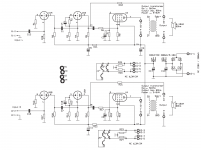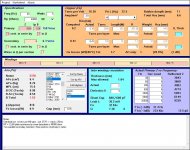Hi,
I have a class a se amp project with EL84 tube. But I can't find output transformer in my country. I am looking for the winding technical information of the transformer with technical data below.
-Primary part wire cross-section and number of turns.
-Secondary part wire cross-section and number of turns.
I'm sorry, my English is not very good.
Primary impedance : 5K
Secondary impedance : 0 - 4 - 8 ohm
frequency response : 20Hz ~ 40KHz
output power : 8 ~10 watt
I have a class a se amp project with EL84 tube. But I can't find output transformer in my country. I am looking for the winding technical information of the transformer with technical data below.
-Primary part wire cross-section and number of turns.
-Secondary part wire cross-section and number of turns.
I'm sorry, my English is not very good.
Primary impedance : 5K
Secondary impedance : 0 - 4 - 8 ohm
frequency response : 20Hz ~ 40KHz
output power : 8 ~10 watt
It was a quite common type of transformer. Almost all TV, radio and phonographs had one of them.
At first instance during the first test you can use a power transformer although distortion be somewhat increased because of lack of air gap in the core.
Using for example, a transformer whose primary is for 220VAC, and your speakers are 8R, then choice a transformer designed for 9VAC:
(220/9)^2 × 8R = 4780R
Very close to the desired 5Kohms.
At first instance during the first test you can use a power transformer although distortion be somewhat increased because of lack of air gap in the core.
Using for example, a transformer whose primary is for 220VAC, and your speakers are 8R, then choice a transformer designed for 9VAC:
(220/9)^2 × 8R = 4780R
Very close to the desired 5Kohms.
You live in the EU. Someone will have transformers. Ask here: https://www.nostubestore.com/p/contact-iletisim.htmlI have a class a se amp project with EL84 tube. But I can't find output transformer in my country.
jeff
Are the calculations below correct? And does the data work?Oldukça yaygın bir transformatör tipiydi. Neredeyse tüm televizyon, radyo ve fonograflarda bunlardan biri vardı.
İlk test sırasında ilk etapta bir güç trafosu kullanabilirsiniz, ancak çekirdekte hava boşluğu olmaması nedeniyle bozulma biraz artabilir.
Örneğin, primeri 220VAC olan ve hoparlörleriniz 8R olan bir transformatör kullanarak 9VAC için tasarlanmış bir transformatör seçin:
(220/9)^2 × 8R = 4780R
İstenen 5Kohm'a çok yakın.
Tube :EL84
Primary impedance : 5K
output power : 5 watt
Primary Voltage :141Vrms
Secondary Voltage :5.5 Vrms (for 8ohm) 3.9Vrms (for 4ohm)
(141/5.5)^2x8R=5258R
(141/3.9)^2x4R=5228R
Attachments
May be. Sincerely I never used software for my transformers. But I can't see the air gap needed. This is important for properly avoiding DC saturation in the core. If DC current is small and primary turns too, thus simply leaving all E laminations inside the core and all l toghether, a natural small gap will be created, but you will need to increase both winding's turns quantity.
I don't expect a perfect output transformer. It will be an amateur job. I had a trial before by purchasing a ready-made output transformer from aliexpres. Can't you write me the winding details of the OPT for these technical details.May be. Sincerely I never used software for my transformers. But I can't see the air gap needed. This is important for properly avoiding DC saturation in the core. If DC current is small and primary turns too, thus simply leaving all E laminations inside the core and all l toghether, a natural small gap will be created, but you will need to increase both winding's turns quantity.
I used the PP version of the ATRA0211 from Ask Jan First. Have been very happy with the sound, and are quite reasonable.
But another option is to look out for an old reel-to-reel Taperecorder or console radio. They are normally a single ECL86 or EL84 power stage, and you get some tubes and hardware for free with the OPT.
But another option is to look out for an old reel-to-reel Taperecorder or console radio. They are normally a single ECL86 or EL84 power stage, and you get some tubes and hardware for free with the OPT.
Last edited:
1. Power = ((Vrms)Squared) / Load Impedance
141Vrms squared / 5000 Ohms = 4 Watts (not 5 Watts).
141Vrms x 1.414 = Volts Peak = 200V peak.
Have fun getting 5 Watts - (undistorted, good frequency response, and good damping factor), from a single ended EL84 in Pentode mode (hard to do).
2. As long as you are winding your own single ended output transformer, you may want to include an Ultra Linear Tap.
For an EL84, perhaps 26% from B+ to the UL tap, and of course finishing the primary to 100% (5k Ohms).
That way, you can easily compare the differences of power, distortion, and damping factor of Pentode mode, UL mode, and Triode mode.
Start all that without using negative feedback (you can do that later).
Negative feedback reduces gain and distortion, but increases damping factor.
141Vrms squared / 5000 Ohms = 4 Watts (not 5 Watts).
141Vrms x 1.414 = Volts Peak = 200V peak.
Have fun getting 5 Watts - (undistorted, good frequency response, and good damping factor), from a single ended EL84 in Pentode mode (hard to do).
2. As long as you are winding your own single ended output transformer, you may want to include an Ultra Linear Tap.
For an EL84, perhaps 26% from B+ to the UL tap, and of course finishing the primary to 100% (5k Ohms).
That way, you can easily compare the differences of power, distortion, and damping factor of Pentode mode, UL mode, and Triode mode.
Start all that without using negative feedback (you can do that later).
Negative feedback reduces gain and distortion, but increases damping factor.
Can you post a schematic or link of the amplifier you're building? EL84 is a popular tube for audio and most manufacturers have a ready-made transformer in their catalogue. That would be the most logical way to proceed.
I can second that the transformers from Ask Jan First (in Germany) are hard to beat price/quality. Toroidy (Poland) is one step up.
I can second that the transformers from Ask Jan First (in Germany) are hard to beat price/quality. Toroidy (Poland) is one step up.
This is schematic.Can you post a schematic or link of the amplifier you're building? EL84 is a popular tube for audio and most manufacturers have a ready-made transformer in their catalogue. That would be the most logical way to proceed.
I can second that the transformers from Ask Jan First (in Germany) are hard to beat price/quality. Toroidy (Poland) is one step up.
Attachments
I think any standard el84 SE transformer would work with this schematic. ATRA0288 is nice: https://www.die-wuestens.de/eindex.htm (See Catalogue > transformers and chokes > OPTS)This is schematic.
If you're not already set on the schematic you posted, the RH84 amplifier would be a better choice: http://rh-amps.blogspot.com/2013/02/rh84-amplifier-revision-2_26.html . Proven design that sounds great.
Hi,
This is just an example of calculation that can be used as a working base.
It can be optimized according to the diameter of the available wires and the number of turns for a full layer.
It is necessary also to pay attention to the space available for isolation paper and copper.
This is just an example of calculation that can be used as a working base.
It can be optimized according to the diameter of the available wires and the number of turns for a full layer.
It is necessary also to pay attention to the space available for isolation paper and copper.
Attachments
Do you plan to build the transformer yourself? If you bring the specification to a generic winder, it may ask a premium to use EI78 laminations because industrial power and control transformers are usually 100VA or more, with bigger core and wire diameter. A smaller transformer may require extra time due to the uncommon machine setup and delays to source the plastic bobbin support, but it may not explain this to you and simply ask a higher price and/or lead time. You may use the software to calculate another option with bigger core, and ask for quotations for both. It may also be cheaper to have the 5 winding ends individually accessible on the bobbin support, this way the winder will not need to make the series/parallel connections. This will save some winding time and avoid a possible error if the winder does not know output transformers requirements. I've seen this trick done on some low-cost transformers.
- Home
- Amplifiers
- Tubes / Valves
- EL 84 SE 5K Output Transformer


